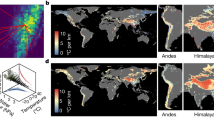Abstract
The roles of area—its size, shape and possible subdivision—in the conservation of species is an important but controversial topic1–5. The fundamental assumption is that nature reserves act as habitat islands in an inhospitable sea of environment that has been modified by man, and thus that the empirical and theoretical findings of island biogeography are pertinent. Empirical studies of oceanic islands and continental habitat islands show that larger areas hold more species. The relationship between these two variables is such that a 100% increase in area produces roughly a 25% increase in species. Thus, two small habitat islands which have more than this 25% difference in their species composition, hold more species than a single habitat island of the same total area. This is probably due to microhabitat differences between these two smaller habitat islands. Yet, even against a constant ecological background, stochastic fluctuations (‘turnover’) of species due to random colonization and extinction6 will cause inter-island variation in species composition.
This is a preview of subscription content, access via your institution
Access options
Subscribe to this journal
Receive 51 print issues and online access
$199.00 per year
only $3.90 per issue
Buy this article
- Purchase on Springer Link
- Instant access to full article PDF
Prices may be subject to local taxes which are calculated during checkout
Similar content being viewed by others
References
May, R. M. Nature 254, 177–178 (1975).
Diamond, J. M. Biol. Conserv. 7, 129–146 (1975).
Simberloff, L. S. & Abel, L. G. Science 191, 285–286 (1976); Science 193, 1027–1032 (1976).
Terborgh, J. Bioscience 24, 715–722 (1974).
Terborgh, J. Tropical Ecological Systems: Trends in Terrestrial and Aquatic Research (Springer, Berlin, 1974).
MacArthur, R. H. & Wilson, E. O. The Theory of Island Biogeography (Princeton University Press, 1967).
Higgs, A. J. & Usher, M. B. Nature 285, 568–569 (1980).
Diamond, J. M. & Marshall, A. G. J. anim. Ecol. 46, 703–727 (1977).
Diamond, J. M. & Marshall, A. G. Emu 76, 187–200 (1976).
Diamond, J. M. Ecology and Evolution of Communities (Harvard University Press, Cambridge, 1975).
Gilpin, M. E. & Diamond, J. M. Proc. natn. Acad. Sci. U.S.A. 73, 4130–4134 (1976).
Author information
Authors and Affiliations
Rights and permissions
About this article
Cite this article
Gilpin, M., Diamond, J. Subdivision of nature reserves and the maintenance of species diversity. Nature 285, 567–568 (1980). https://doi.org/10.1038/285567a0
Received:
Accepted:
Issue Date:
DOI: https://doi.org/10.1038/285567a0
This article is cited by
-
Lessons from insect conservation in Russia
Journal of Insect Conservation (2019)
-
The relationship between nested subsets, habitat subdivision, and species diversity
Oecologia (1995)
-
The effect of insularity on the diversity of land birds in the Fiji islands: implications for refuge design
Oecologia (1993)
-
Effects of habitat fragmentation and isolation on species richness: evidence from biogeographic patterns
Oecologia (1988)
Comments
By submitting a comment you agree to abide by our Terms and Community Guidelines. If you find something abusive or that does not comply with our terms or guidelines please flag it as inappropriate.



